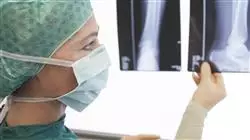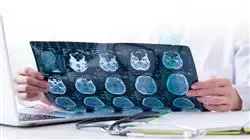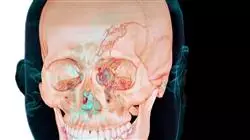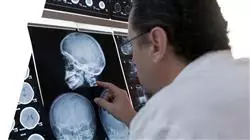University certificate
The world's largest faculty of medicine”
Description
With this 100% online Postgraduate diploma, you will master the most innovative Ultrasound techniques to identify damage to internal organs and provide relevant evidence to clarify the causes of death"

One of the main challenges for Forensic Radiology specialists lies in the anatomical complexity of the maxillofacial region. Although imaging techniques have advanced considerably thanks to technologies such as Computed Tomography, there are still technical limitations in the detection of specific lesions. For example, maxillofacial trauma may involve dense bone fractures or soft tissue injuries that can be difficult to appreciate. Given this reality, clinicians have a responsibility to deepen their understanding of both oral physiology. Only then will they be able to recognize both normal features and anatomical variants and obtain transcendental findings through radiological imaging.
To contribute to this task, TECH has developed an exclusive Postgraduate Diploma in Forensic Radiology in Human Identification.
Designed by references in this field, the syllabus will analyze in depth the use of more sophisticated radiodiagnostic tools (including MRI, Virtopsias or Ultrasound). In turn, graduates will gain advanced practical skills to detect anatomical particularities relevant to the identification of individuals, such as diseases, traumas or anomalies. In this regard, the specialization will provide the keys to establish the age of individuals based on the ossification of cartilage. The academic materials will also delve into the Stages of Bone Repair, so that experts can determine the time elapsed from injury to death.
On the other hand, this program is taught in a 100% online mode, allowing the specialists to enter the program comfortably. In this way, the only thing they will need to update their knowledge is a device with Internet access (using their cell phone, computer or tablet). The program also offers the most avant-garde methodology on the market today: Relearning. This teaching system is based on the reiteration of the most important contents to guarantee a natural learning process that will last in the memory of the graduates.
You will be able to determine the ages of individuals from details such as the closure of bony epiphyses and cranial sutures"
This Postgraduate diploma in Forensic Radiology in Human Identification contains the most complete and up-to-date scientific program on the market. The most important features include:
- The development of practical cases presented by experts in Forensic Radiology
- The graphic, schematic and eminently practical contents with which it is conceived gather scientific and practical information on those disciplines that are indispensable for professional practice
- Practical exercises where the self-assessment process can be carried out to improve learning
- Its special emphasis on innovative methodologies
- Theoretical lessons, questions to the expert, debate forums on controversial topics, and individual reflection assignments
- Content that is accessible from any fixed or portable device with an Internet connection
You will delve into the procedure of Diagnostic Angiography to visualize blood vessels in different parts of the body, such as arteries and veins"
The program’s teaching staff includes professionals from the field who contribute their work experience to this educational program, as well as renowned specialists from leading societies and prestigious universities.
The multimedia content, developed with the latest educational technology, will provide the professional with situated and contextual learning, i.e., a simulated environment that will provide immersive education programmed to learn in real situations.
This program is designed around Problem-Based Learning, whereby the professional must try to solve the different professional practice situations that arise during the course. For this purpose, students will be assisted by an innovative interactive video system created by renowned and experienced experts.
Delve into Forensic Maxillofacial Trauma at the best digital university in the world according to Forbes"

Thanks to TECH's revolutionary Relearning methodology, you will integrate all the knowledge in an optimal way to successfully achieve the results you are looking for"
Syllabus
This Postgraduate diploma will provide specialists with the necessary skills to master the most innovative radiological techniques for Human Identification. To achieve this, the academic itinerary will delve into the analysis of the human skeleton and the procedures for biological detection.
Therefore, graduates will be able to locate individual characteristics of people in radiological images (such as anatomical variations or medical implants). The contents will also delve into the radiodiagnosis of pathologies linked to forensic investigation. In line with this, the program will analyze the specificities of situations of child abuse and illegal transport of narcotics.

Module 1. Forensic Radiology in Human Identification
1.1. Human Identification in the Forensic Context
1.1.1. In Police Cases
1.1.2. In Judicial Cases
1.1.3. In Crimes Against Humanity and War Crimes
1.1.4. In Major Disasters
1.2. The Human Skeleton and Biological Identification (I): Osteological Sexual Characterization in Adults
1.2.1. Sexual Characterization Through the Skull
1.2.2. Sexual Characterization Through the Hip
1.2.3. Osteological Sex Characterization from Other Bones
1.3. The Human Skeleton and Biological Identification (II): Osteological Sexual Characterization in Individuals in Maturing Stages
1.3.1. Sexual Characterization Through the Skull
1.3.2. Sexual Characterization Through the Hip
1.3.3. Osteological Sex Characterization from Other Bones
1.4. The Human Skeleton and Biological Identification (III): Determination of Age at Death in Adult Individuals
1.4.1. Age Determination from the Closure of Bone Epiphyses and Cranial Sutures
1.4.2. Age Determination from Cartilage Ossification
1.4.3. Age Determination from the Modification of Bone Regions
1.5. The Human Skeleton and Biological Identification (IV): Age Determination at Death in Maturing Individuals
1.5.1. Determination of age from Morphometrics
1.5.2. Age Determination by Bone Birth
1.5.3. Age Determination by Epiphyseal and Fontanel Closure
1.6. The Human Skeleton and Biological Identification (V): Determination of Stature and Muscular Build
1.6.1. Estimation of Stature of Anatomical Nature
1.6.2. Estimation of Stature of Physiological Nature
1.6.3. Bone Biomechanics and Adaptation to Physical Activity
1.6.4. Development of Muscular Complexion
1.7. Human Dentition for the Calculation of Age at Death
1.7.1. The Dentition in Maturing Individuals
1.7.2. Dentition in Adult Individuals
1.7.3. Dental Alterations and Pathologies
1.8. Biomechanics and Mechanical Forces Applied to Bone Trauma
1.8.1. Osteological Growth and Development
1.8.2. Mechanical Forces Applied to the Human Skeleton
1.8.3. Bone Adaptation to Exercise
1.9. Bone Trauma due to Temporality
1.9.1. Characterization of AntemortemTraumas
1.9.2. Characterization of PerimortemTraumas
1.9.3. Characterization of PostmortemTrauma
1.10. Trauma by Type of Injury
1.10.1. Classification by Type of Injury
1.10.2. Classification by Type of Weapon
1.10.3. Classification by Type of Object and Structure
Module 2. Radiodiagnosis of Pathologies Related to Forensic Investigation
2.1. Classification of Traumatic Fractures in the Forensic Context
2.1.1. Classification According to Skin Condition
2.1.2. Classification According to Location
2.1.3. Classification According to Fracture Trace
2.2. Stages of Bone Repair in the Forensic Context
2.2.1. Inflammatory Phase
2.2.2. Repair Phase
2.2.3. Remodelling Phase
2.3. Child Maltreatment and its Radiodiagnosis in a Forensic Context
2.3.1. Simple Radiography
2.3.2. Axial Tomography
2.3.3. Magnetic Resonance
2.4. Illegal Transport of Narcotics and Radiodiagnostics in a Forensic Context
2.4.1. Simple Radiography
2.4.2. Axial Tomography
2.4.3. Magnetic Resonance
2.5. Simple Radiographic Technique for Identification of Alterations within a Forensic Context
2.5.1. Cranial Pathologies
2.5.2. Thoracic Pathologies
2.5.3. Extremity Pathologies
2.6. Ultrasound Technique for Identification of Pathologies within a Forensic Context
2.6.1. Ultrasound
2.6.2. Obstetric
2.6.3. Wall
2.7. Computed Tomography and Identification of Pathologies in a Forensic Context
2.7.1. Cranial
2.7.2. Wall
2.7.3. Ultrasound
2.8. Magnetic Resonance Imaging and Pathology Identification in a Forensic Context
2.8.1. Cranial
2.8.2. Wall
2.8.3. Ultrasound
2.9. Diagnostic Angiography in a Forensic Context
2.9.1. Cranial
2.9.2. Ultrasound
2.9.3. Extremities
2.10. Virtopsia, Radiology in Forensic Medicine
2.10.1. Resonance
2.10.2. Tomography
2.10.3. Radiography
Module 3. Forensic Radiodiagnosis of Maxillofacial Trauma
3.1. Forensic Maxillofacial Trauma: Fractures of the Upper Third of the Face
3.1.1. Fractures of the Frontal Bone
3.1.2. Fractures of the Walls of the Frontal Sinuses
3.1.3. Fractures of the Temporal/Parietal Bone
3.2. Forensic Maxillofacial Trauma: Fractures of the Middle Third of the Face
3.2.1. Nasal Fractures
3.2.2. Orbital Fractures
3.2.3. Fractures of the Naso-Orbito-Ethmoidal Complex
3.2.4. Fractures of the Zygomatic Bone
3.3. Forensic Maxillofacial Trauma: Fractures of the Lower Third of the Face.
3.3.1. Fracture of the Mandibular Symphysis / Parasymphysis
3.3.2. Fracture of the Mandibular Body
3.3.3. Mandibular Angle Fracture
3.3.4. Mandibular Ramus Fracture
3.3.5. Fracture of the Mandibular Condyle
3.4 Forensic Maxillofacial Trauma: Le Fort Fractures
3.4.1. Le Fort I Fractures
3.4.2. Le Fort II Fractures
3.4.3. Le Fort III Fractures
3.4.4. Le Fort IV Fractures
3.5. Forensic Maxillofacial Trauma: Alveolodental Fractures
3.5.1. Coronary Fracture
3.5.2. Corono-Radicular Fracture
3.5.3. Root Fracture
3.5.4. Alveolar Fracture
3.5.5. Avulsion
3.6. Radiographic Techniques for the Study of Maxillofacial Trauma in the Forensic Context.
3.6.1. X-Ray
3.6.2. Computerized Axial Tomography
3.6.3. Other Radiographic Techniques
3.7. Radiographic Techniques for the Study of Alveolar Tooth Trauma in the Forensic Context
3.7.1. X-Ray
3.7.2. Computerized Axial Tomography
3.7.3. Other Radiological Techniques
3.8. Radiographic Interpretation of Maxillofacial Trauma in the Forensic Context: Isolated Fractures
3.8.1. Radiographic Interpretation of Trauma to the Upper Third of the Face
3.8.2. Radiographic Interpretation of Trauma of the Middle Third of the Face
3.8.3. Radiographic Interpretation of Trauma of the Lower Third of the Face
3.9. Radiographic Interpretation of Maxillofacial Trauma Within the Forensic Context Le Fort Fractures
3.9.1. Radiographic Interpretation in Le Fort I Fractures
3.9.2. Radiographic Interpretation in Le Fort II Fractures
3.9.3. Radiographic Interpretation in Le Fort III Fractures
3.9.4. Radiographic Interpretation in Le Fort IV Fractures
3.10. Radiographic Techniques for the Study of Alveolar Tooth Trauma in the Forensic Context
3.10.1. Coronary Fracture
3.10.2. Corono-Radicular Fracture
3.10.3. Alveolar Fracture
3.10.4. Root Fracture
3.10.5. Avulsion

TECH gives you access to one of the best virtual libraries, so that you can enjoy continuous updating. What are you waiting for to enroll?"
Postgraduate Diploma in Forensic Radiology in Human Identification
Forensic radiology plays an essential role in the identification of individuals in cases of natural disasters, serious accidents, and crimes. Are you looking to specialize in the field of forensic radiology and human identification? This Postgraduate Diploma created by TECH Global University offers you a unique opportunity to acquire specialized and advanced knowledge in this crucial field of forensic science! Through this program, taught completely online, you will immerse yourself in the study of advanced imaging techniques, including X-rays, computed tomography (CT) scans, magnetic resonance imaging (MRI) and more. As you progress through the program, you will learn to interpret and analyze radiologic images to identify unique features of the human skeleton such as dental structures, medical implants and distinctive bone features.
Postgraduate Diploma in Forensic Radiology in Human Identification
The faculty is made up of experts in forensic radiology, forensic anthropology and forensic medicine, who will guide you throughout your education and provide you with a unique perspective based on their practical experience in the field. In addition to the technical aspect, our program also focuses on developing communication and teamwork skills, as interdisciplinary collaboration is essential in the field of forensic radiology. You will learn to communicate your findings clearly and concisely in both written reports and oral presentations. Upon successful completion of the program, you will be prepared for key roles in the field of forensic radiology and human identification, including forensic expert witness, forensic radiologist, forensic anthropologist and more. This program will provide you with a valuable, internationally recognized credential that will open doors in the exciting and challenging world of forensic science. Take the opportunity to advance your career and become an expert in human identification. Enroll now and take the first step towards an exciting future in forensic radiology!







